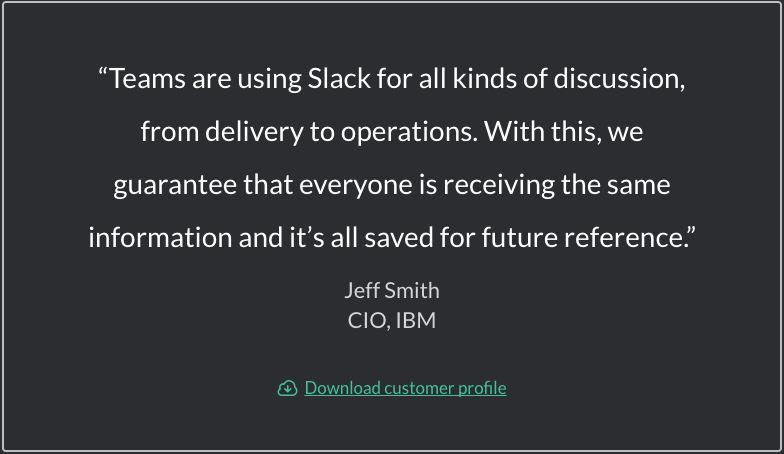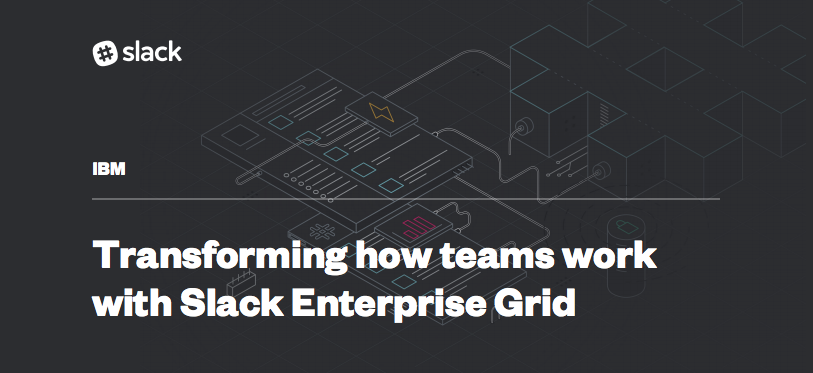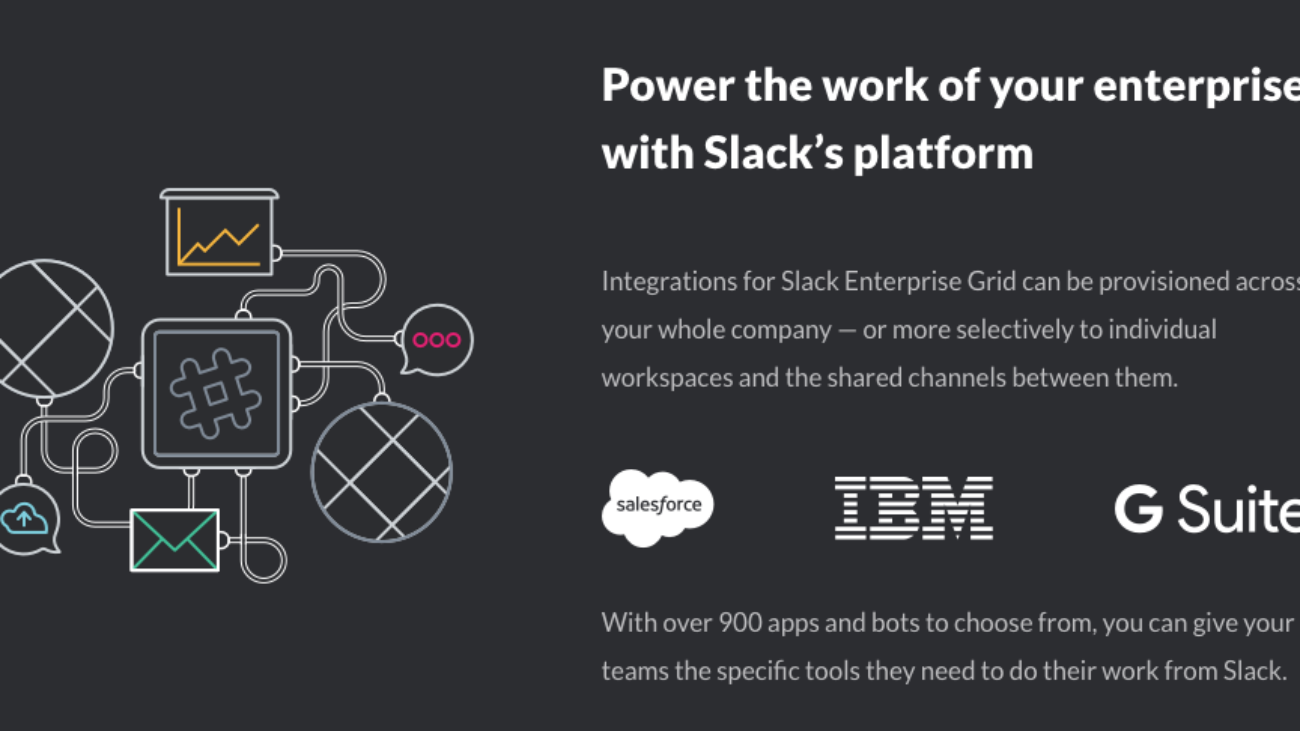TechCrunch yesterday reported on Slack’s plans to unveil an enterprise version of its service:
Slack, the business app that lets teams of users communicate, share files from other services, and work on them with each other, has taken off like wildfire since launching three years ago, with 5 million daily users, 1.5 million of them paying today. Now, Slack is embarking on the next step in its ambition to be the go-to platform for all workplace collaboration, no matter how big the company may be.
(Or up to 500,000 employees, to be more specific.)
[T]he eponymous company behind the app is today launching Enterprise Grid — a new product aimed at corporates and other very large enterprises.
All good news and not wholly unexpected so far. But then it gets a little bit weird…
The new version goes live today, and to kick it off, Slack is announcing some initial customers: financial services giant Capital One, Paypal and IBM.
IBM is a particularly interesting name to see here, given that it sells its own collaboration product for large enterprises, IBM Connections, and it is also working on what appears to be its own AI business intelligence product, Watson Workspace. Other would be competitors include Workplace from Facebook, Microsoft’s Teams, Jive and Spark from Cisco.
Yep, IBM is named as one of the reference customers for this new enterprise Slack service, despite having recently launched its own AI-driven chat service, Watson Workspace.
Many of us already knew that IBM were using Slack internally – I got to see that first-hand on a visit to the Austin Design Lab back in the summer – but it is still a surprise to see IBM named so dramatically on a competitor’s launch communications:

The ‘customer profile’ linked from the Slack site goes directly to this PDF, stating:
[IBM CIO, Jeff] Smith cites that he’s able to have more consistent, dynamic conversations with his direct reports in Slack, reducing his meeting load. He’s also able to deliver messages to the right audiences and avoid blasting people with information not relevant to them. The fact that he can send messages to team members even when they aren’t logged in is another bonus, given the nature of his globally- distributed team.For Smith, much of the value of Slack comes from the fact that it aligns with his vision for how teams should work together. “Collective intelligence will always outweigh individual insights,” he says. And with the additional security provided by Slack Enterprise Grid, there was little hesitation in his decision to get the whole team on board.
Don’t get me wrong, I’ve long argued that IBMers (including those in Lotus/ICS) needed to use competitor solutions in anger in order to better understand their value, their USPs, and the user experience they delivered. I remember making that point regarding Dropbox in particular back in the days of Lotusphere. Therefore I have no issue with IBMers (particular in the IT/CIO office, where extensions and integrations with support platforms are so important) using Slack, nor with IBM integrating Slack into their own solutions.

However, it does seem a little tone-deaf to be so actively promoting a competitor’s enterprise solution on day of release, when there is a similar IBM offering (Watson Workspace) currently in preview mode and likely to be formally launched in 2017, plus numerous other IBM solutions (Verse, Connections, Sametime) that make similar claims regarding the ability to transform work practices.
Let’s take this paragraph from the reference PDF:
Smith notes that it’s not just people who are communicating in Slack. His team has connected numerous apps and integrations that push information from other services directly into Slack channels, sparing team members from having to switch between apps while also allowing them to quickly spot, discuss, and resolve issues. Alerts from other tools and services show up in Slack channels as new deployments go live or any issues in the delivery pipeline need attention.
and instead write it as:
Smith notes that it’s not just people who are communicating in Connections. His team has connected numerous apps and integrations that push information from other services directly into Connections communities, sparing team members from having to switch between apps while also allowing them to quickly spot, discuss, and resolve issues. Alerts from other tools and services show up in Connections activity streams as new deployments go live or any issues in the delivery pipeline need attention.
Wouldn’t that be a fantastic case study for IBM to be sharing with ICS customers at IBM Connect 2017 later this month?
If I was attending Connect as an IBM partner, I’d be asking the ICS execs some tough questions on what it means for IBM at a corporate level to be promoting competitor products ahead of their own solutions.
What do you think? Does it give you additional confidence in your investment in ICS solutions that IBM is working so closely with competitors like Slack, Box and Cisco? Or are you worried that this signifies a lack of positive reinforcement of quality of their own solutions in this area? I’d love to hear from you!



Stuart,
It’s good to see you blogging again here more regularly. Please keep doing so – it’s good to read your point-of-view.
I’m with you on this one – the IBM use of Slack is weird, since they supposedly have their own stuff. It is very confidence undermining.
M.
Thanks for the comment, Michael. I’m definitely enjoying being more active on this blog again this year.
Hi Stuart, I am hoping the way that what appears to be inconsistent messaging is in fact consistent… is a scenario in which IBM start building clients that interact with data held on other platforms. Remember way back in the earlier days of SameTime it was going to be possible to chat with people using other IM products or the early previews of Verse where they talked about Verse being a mail client that could sit on top of Exchange. IBM are pretty late to the persistent chat market they are probably only going to penetrate the market if it doesn’t become a choice on Watson Workspace over Slack but one of you use the one you like and i will use the one I like, but we can still communicate with each other. In the world of Blackberry it was possible to dictate the smartphone employees used. We now live in an era of BYOD and Bring Your Own Client. I have my own device with my preferred Mail, Calendar, Contacts, Message, and other Social clients, just let me plug them in to your data and infrastructure so we can interact without having to fight over using a single proprietary vertical stack platform. Jeff Smith can use Slack and Ed Brill can use Watson Workspace.